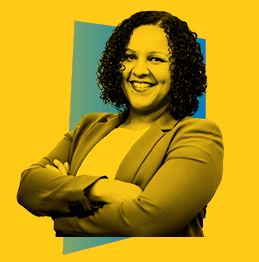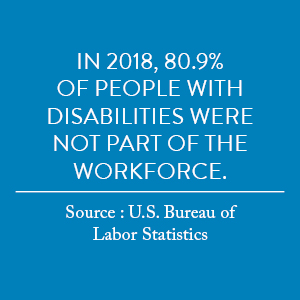
Did you know that one in four people in the United States has a disability (Center for Disease Control and Prevention)?
The changing demographics of the workforce coupled with low rates of unemployment puts organizations in a place where they need to be innovative when it comes to recruiting, hiring, and retaining employees.
Lifeworks sat down with our Disability Inclusion Consultant, Ashley Oolman, to learn more about disability employment and inclusion in the workforce. Using evidence-based, best practices, Oolman provides accessibility assessments, one-to-one consultation, inclusion workshops, and organization-wide trainings for business, guiding strategic diversity, equity, and inclusion efforts to transform workplace culture and advance human rights for all people.
What is disability inclusion?
Oolman: Inclusion is a conscious choice tied to action. Decisions have been made and spaces have been created for years without people with disabilities in mind – so essentially it is the intentional undoing of barriers and recognizing the value of including all people.
Why is disability inclusion important?
Oolman: People have the right to be employed. Often a lot of what gets in the way is not a person’s disability, but rather bias, perspectives, and stigmas that are widely believed and are huge barriers. When you open up dialogue and break those concepts apart, it becomes clear that they are not reasons to avoid hiring people with disabilities.
Employment provides a greater level of access to rights and liberties. It’s not just about earning money, but it’s also about being able to accumulate wealth, provide for family, give back to the community, and invest in what matters to you.
What are some misconceptions about employees with disabilities?
Oolman: A common misconception is that people with disabilities cannot do the same work at the same level or productivity as those without disabilities and are therefore not as valuable as employees.
Another misconception that I’ve encountered in my work is that all people with disabilities need expensive accommodations. Not only is this belief inaccurate, but when an accommodation is needed, it is often addressing a barrier that positively impacts factors like the workflow and productivity.

Why should employers diversify their talent?
Oolman: If you’re trying to solve a problem, make a decision, or develop a product, having different perspectives at the table is valuable. Employers know this and that’s why they are investing in diversity and inclusion efforts.
But one important concept to understand is that it is not a numbers game. Having a person with a disability or a person of color is not enough – to ensure that employees can be their best, authentic selves, the work culture needs to shift to represent the community – and be a place where everyone can contribute.
Also, if you are selling a product or a service and your goal is to be as profitable as you can, the more you can appeal to the masses and differentiate what you do, the better. Do you want to sell to one group of people or do you want to make something that is so amazing that everyone can use?
What steps can employers take to become more inclusive?
Oolman: Step one is to get started. There are so many ways to take the first step. I recommend becoming acclimated with information about people with disabilities. There are some great resources out there such as the Employer Assistance and Resource Network on Disability (EARN) and the Office of Disability Employment Policy (ODEP).
The second step is to create the space for conversations about diversity, equity, and inclusion to happen – and make sure that everyone’s voice is heard. The goal of the conversations should be to challenge perceptions, establish inclusive policies and practices, and create a plan that connects to strategic initiatives.
To learn more about Lifeworks Disability and Inclusion Resources and to book a consultation at your business, visit: lifeworks.org/worklifemn
